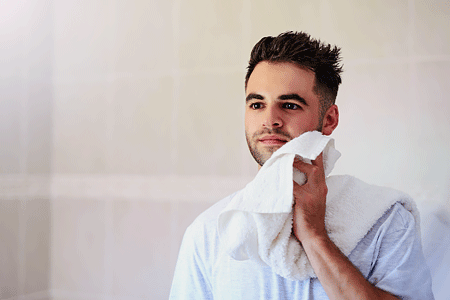Ringworm: 12 tips for getting the best results from treatment
When treating a ringworm infection, it’s important to use an anti-fungal medicine. To get the best results and prevent the infection from spreading to other areas of your body, dermatologists recommend the following:
Treat the area for as long as recommended. Anti-fungal medicine may work quickly. You may see clearing or no longer feel symptoms in a few days.
After touching the area with ringworm, wash your hands before touching another area of your body. Touching or scratching the area with ringworm and then touching another area can spread ringworm from one part of your body to another. Washing your hands well can help prevent this.
Keep the infected area clean and dry. The fungus that causes ringworm thrives in warm, moist areas, so you want keep the area clean and dry.
Keep the area clean and dry
Using a different towel to dry off the area infected by ringworm can improve treatment results.

Treat all ringworm at the same time. If you have athlete’s foot and ringworm on your hands, it’s important to treat both your feet and hands. If you treat only one area, you’ll still have a ringworm infection. The infection can quickly spread to other areas again.
Change your clothes, including underwear and socks, every day. Wash the clothes before wearing them again. This includes clothes you wear to work out.
Shower after working out. Fungi thrive in moist, warm areas. You want to wash away perspiration and keep the area dry.
Avoid sharing towels and other personal items. You can easily spread ringworm to others by sharing towels, hats, combs, and other personal items. The fungi can survive on objects for a long time.
Wear shower thongs or waterproof shoes in locker rooms, showers that others use, and pool areas. If you have athlete’s foot, this helps prevent spreading it to others. It also gives you some protection if someone else has ringworm.
Disinfect or throw out infected items. The fungi that cause ringworm can survive for a long time.
If you suspect your pet has ringworm, take the animal to your vet. It’s possible to catch ringworm from an animal. Dogs, cats, and other animals can pass ringworm to humans. Just as there are effective treatments for people, there are effective ringworm treatments for pets.
If treatment fails to clear the rash, tell your dermatologist. Virtually every case of ringworm can be successfully treated.
Keep all follow-up appointments with your dermatologist. Ringworm often clears with the first treatment a dermatologist prescribes. Sometimes, ringworm can be stubborn or patients unknowingly do something that prevents the treatment from working. For these reasons, it best to keep follow-up appointments.
After ringworm clears, it’s possible to get it again. Ringworm is very contagious. You can, however, reduce your risk. You’ll discover ways to prevent athlete’s foot, a common type of ringworm, by watching, Athlete’s foot: How to prevent
Image
References
Centers for Disease Control. Healthy Pets, Healthy People: Ringworm. Last accessed April 19, 2016.
 Atopic dermatitis: More FDA-approved treatments
Atopic dermatitis: More FDA-approved treatments
 Biosimilars: 14 FAQs
Biosimilars: 14 FAQs
 How to trim your nails
How to trim your nails
 Relieve uncontrollably itchy skin
Relieve uncontrollably itchy skin
 Fade dark spots
Fade dark spots
 Untreatable razor bumps or acne?
Untreatable razor bumps or acne?
 Tattoo removal
Tattoo removal
 Scar treatment
Scar treatment
 Free materials to help raise skin cancer awareness
Free materials to help raise skin cancer awareness
 Dermatologist-approved lesson plans, activities you can use
Dermatologist-approved lesson plans, activities you can use
 Find a Dermatologist
Find a Dermatologist
 What is a dermatologist?
What is a dermatologist?
